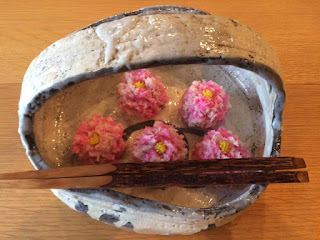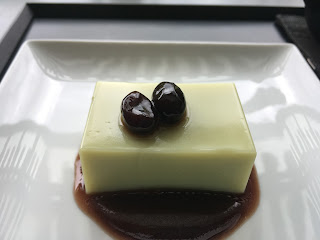I recently visited Kyoto, Japan with my Chado (Japanese Tea Ceremony) Sensei and three other students. I learned so much about Chado and Japanese culture. We had lovely weather and incredibly generous local hosts. A primary goal was to have sweets and tea every day (often more than once). And so... an obvious way to start summarizing is through a sweets play-by-play! Here's most of them, with a bite of context for each. (Not included are some very special sweets from events we attended that will live on in our hearts, but not in photos.)
Photo credit: Marjorie Yap
These sweets hold a special place in my heart. They were from our first tea experience in Kyoto, at Ochaji Cafe.
Yamaguchi-san gently guided our jet-lagged bodies and minds through a lovely light meal, thick tea (koicha) and thin tea (usucha). The sweets above are the traditional kinton style of wagashi ("wet" sweet), soft sweet bean or sweet potato paste that has been grated. It's served before koicha. So delicious and lovely. The sweets below (higashi, "dry" sweets) were served just before the usucha. Crunchy apple-flavored sugars, chewy jelly strips and senbei (crispy rice crackers, lightly sweetened, with a thin film of miso paste).
Photo credit: Marjorie Yap
We enjoyed the persimmon mochi sweet below in Arashiyama. The outer dough is soft and chewy, filled with a persimmon/bean paste. The tops are from real persimmons.
This beauty is from a sweets bar (think sushi bar), where the expert makes the sweet right in front of you. If you haven't figured this out, sweets in Japan are all about seasonality! This is a chrysanthemum.
The sweets below were from an assortment served to us at the famous Ippodo shop on Teramachi. Kinton (upper left) in autum colors, wrapped yokan and on the bottom, manju - a rice bun filled with - you guessed it. Bean paste!
A friend and I visited the Kyoto Confectionery Museum. While the descriptions were in all Japanese, we still learned and enjoyed from the experience, especially the tea and sweets at the end. Lucky us, it's chestnut season. We savored a glazed chestnut and a bean paste chrysanthemum.
Now on to Toraya, which is worthy of a post unto itself! For now, let me say that it's a bit of heaven - serene and with great tea and sweets. The two delicacies below are from there. The first, a green soybean (edamame) and silken tofu square, in a brown sugar sauce. The second, yokan with chestnut pieces. (Since being home less than a week, my friend has replicated this yokan with success, I am delighted to say!)
Next up - a sweets class! We got our chance to practice hand forming the sweets. One of these below is the professional ginko leaf, one is not. It's easy to tell. :-)
I did a little better with the persimmon sweet. They all four tasted great.
And here is another (professional) variation of the chrysanthemum. Notice the delicate fade of white to purple in the center. The secrets: lots of patience, practice and precision.
The sweet below is another favorite among favorites. My girlfriend and I were wandering the back streets near Daitokuji temple. We found a tiny little sweets shop (many of them are), which seemed to specialize in this interesting mochi. It's filled with bean paste, with some whole beans to give texture, and a savory/saltiness to the mochi. Unusual and delicious!
Photo credit: Ana Martinez
Another trip to Toraya...
And then a day trip to the famous tea-growing region and tea-company town, Uji. During an informative tour at the matcha company Marukyu-Koyamaen, we enjoyed this dango sweet.
Later that day, after I wandered through tea shop after tea shop, I enjoyed this sweet at the Kanbayashi cafe. It's hard to tell in the photo, but there is a chestnut at the center, and it's surrounded by what might be kudzu-gelatin-based "leaves." that wrap around. Of course, delicious.
Next, a small pause in our schedule before we headed to the countryside for the final leg of the trip. Four sweets below from the Japanese Tea & Gallery Kyoto Saryo in Kyoto Station.
And finally - a feast of sweets to close out our last dinner in Japan.
What an indulgence - to live where there is a Japanese sweets shop within easy walking distance of wherever I go!























































